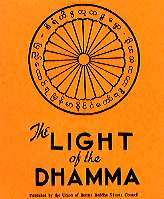
BUDDHIST LITERATURES IN ARCHIVES
U Thein Han,
Research Officer
Vol. 1, No. 2, 1981

|
BUDDHIST LITERATURES IN ARCHIVESU Thein Han, Research Officer Vol. 1, No. 2, 1981 |
 |
First of all, it is necessary to explain what an 'Archives' is. The word, 'Archives' may be defined in many different ways. Archives means a place in which government documents and other official papers are kept. Secondly, it means a place to which public records or other important Historic documents are bestowed. Thirdly, it means a historical record or document so preserved. Hence, an Archives is an institute where essential books, palm-leaf manuscripts, documents, etc. are kept and preserved. Unlike a library, the duty of an Archives is to keep the books, manuscripts and documents in proper order so as to fulfil the desire of all readers and researchers, and also to preserve all of the acquisitions for a long period of time. Archives in Burma may roughly be classified into four kinds, namely:- 1. Government Archives in which the official documents of the government are kept, e.g., National Archives Department. 2. Army Archives in which the documents of all Armed Forces, are maintained, e.g., Tatmadaw Archives Institute. 3. University Archives in which all kinds of books, palm-leaf manuscripts, documents and other papers of academic value, are preserved, e.g., Rangoon Arts and Science University Library. 4. Religious Archives in which books, palm-leaf manuscripts, scrolls, parabaiks, kammavacas, documents, and other scriptures on Canonical Literatures are kept, e.g., Religious Affairs Department Library. Of these four types, I am going to discuss the fourth, namely, the Religious Affairs Department Library since the collections are mainly Buddhist Literatures in the forms of books, palm-leaf manuscripts, etc. |
TIPITAKAS |
| According to Theravada School of Buddhism, the Pali Canon may be classified either as Three Pitakas or Five Nikayas or 84,000 Dhamma Kkhandhas. Whichever classification is made, the original Buddhist Scriptures are all the same. As all Buddhists know well, the main division of the PaliCanon, or Tipitaka, is threefold: Tipitaka means Three (ti), Baskets (pitakas). They are:— (1)Suttanta Pitaka: The Teaching Discourses,(Dhamma), (Three Treatises), (2)Vinaya Pitaka: Rules of Discipline for the Order (Sangha) (Five Treatises). (3)Abhidhamma Pitaka: Philosophical treatment of the Dhamma, (Seven Treatises). |
FIVE NIKAYAS AND FORTY PALI TEXTS |
Again the same Pitakas may also be classified into the following Five Nikayas:—
According to this classification the forty volumes of Pali Canon are classified into five groups or collections. The size of each book as prescribed by the Religious Affairs Department Press is 7 1/2 inches x 11 inches. The Forty Pali texts can be enumerated as follows: I. Digha Nikaya(Three Volumes).
II. Majjhima Nikaya (Three Volumes).
III. Samyutta Nikaya(Three Volumes).
IV. Anguttara Nikaya (Three Volumes).
V. Khuddaka Nikayas (Twenty Eight Volumes). (a) Suttana Pitaka(Eleven Volumes).
(b) Vinaya Pitaka(Five Volumes).
(c) Abhidhamma Pitaka (Twelve Volumes).
|
ATTHAKATHAS |
The Pali Tipitaka Atthakathas as approved by the Sixth Buddhist Council (Chattha Sangayana) are as follows, the size of each book is the same as that of the Pali Canon Books Commentaries (Atthakathas) (51 Volumes).
|
| TIKAS |
The Pali Tipitaka Tikas as approved by the Sixth Buddhist Council (Chattha Sangayana) are as follows; the size of each book is the same as that of the Pali Canon Books:— Sub-Commentaries (Tikas)(26-Volumes).
There are still many other canonical and non-canonical Tika (sub-commentaries) published by the Union Buddha Sasana Council Press. To mention some of them—
|
After the demise of Lord Buddha, these Pitakas, Atthakathas and Tikas are left behind for Theravadi Buddhists to promote the Three Modes of Sasana such as Pariyatti (Learning), Patipatti (Practice) and Pativedha (Wisdom). So, the above- mentioned literatures play an important role in the development of Burmese Culture which is originated from the Buddhist Thought and Buddhist Literatures. The presevational and conservational processes for all these Buddhist Literatures can only be carried out by Archives. Hence, the values of the archival functions are to be considered in maintaining, preserving and conserving all such Buddhist Literatures. Thus, it may well be said that an Archives give vital help to a person who earnestly practises the Dhamma for the positive attainment of Nibbana. |
This page at Nibbana.com was last modified: